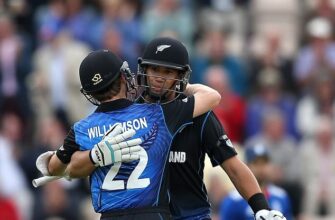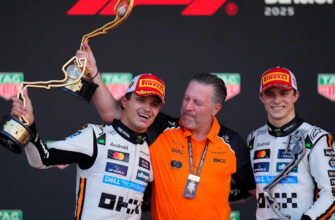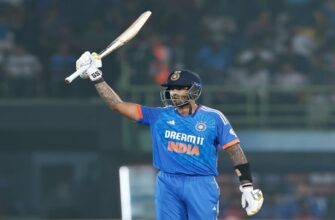In the exhilarating world of Formula 1, where split-second decisions dictate fortunes and championships hang in the balance, the dynamic within a racing team can be as fiercely competitive as the action on track. The recent Singapore Grand Prix offered a stark reminder of this delicate balance, shifting focus from the eventual race winner to a more pressing, internal drama unfolding within the McLaren paddock: the burgeoning rivalry between teammates Lando Norris and Oscar Piastri.
While George Russell celebrated a surprise victory under the dazzling Singaporean lights, the real narrative simmering beneath the surface concerned a first-lap incident involving McLaren’s two young stars. It was a moment of contact that, though swiftly dismissed as a “racing incident” by the FIA stewards, sparked a torrent of questions about team cohesion and the formidable challenge of managing two drivers vying for the sport`s highest honors.
The Flashpoint: Singapore`s Turn 3 Scuffle
The incident itself was a blink-and-you-miss-it affair, a testament to the sheer velocity and precision required in Formula 1. From his fifth-place grid slot, Lando Norris launched an aggressive charge into the opening corners, positioning his McLaren alongside teammate Oscar Piastri. As the trio approached Turn 3 – with Max Verstappen ahead – Norris clipped the rear of the Red Bull, a momentary loss of control that sent his car sliding sideways, directly into Piastri who was attempting to navigate the outside line. The result: front-wing damage for Norris and a less-than-charming impact for Piastri, but critically, Norris gained track position, eventually climbing to a podium finish ahead of his teammate.
On paper, the FIA`s decision was clear: “no further action.” A mere racing incident, the kind that frequently punctuates the chaos of an opening lap. Yet, for McLaren, and particularly for the drivers involved, this was far from a simple deduction.
The Voices from the Cockpit: Frustration and Justification
Oscar Piastri`s immediate reaction over team radio was a visceral burst of frustration. “Are we cool with Lando barging me out of the way, or… what`s the go there?” he queried, followed by a terse exchange with his race engineer, Tom Stallard. From Piastri’s perspective, obscured by the limited view from his cockpit, it appeared his teammate had carelessly swerved into him. His argument was succinct: avoiding another car should not come at the expense of colliding with a teammate. It was a human moment of anger, amplified by the high stakes and adrenaline, and entirely understandable for a driver whose team had previously stressed a “golden rule” of avoiding inter-team contact.
“That`s not fair. Sorry, that`s not fair,” Piastri famously broadcast, encapsulating the raw emotion of being on the receiving end of what felt like an unfair maneuver. His later quip, “if he has to avoid another car by crashing into his teammate, that`s a pretty s— job of avoiding,” underscored a profound dissatisfaction.
Lando Norris, no stranger to criticism for sometimes being *too* reserved on the opening lap, offered a robust defense. His take was pragmatic: “Anyone on the grid would have done exactly the same thing as I did.” He admitted to a slight misjudgment with Verstappen but maintained that the initial aggressive move into the gap was standard racing procedure. For Norris, the pressure of media scrutiny regarding teammate incidents weighs heavily, suggesting an almost self-preservative instinct to clarify his actions. His assertion that he still would have ended up ahead, due to Piastri being on the “dirty side” of the track, speaks volumes about the competitive mindset that overrides niceties in such moments.
McLaren`s “Papaya Rules” on a Tightrope
This incident throws McLaren`s famously articulated “papaya rules” into sharp relief. These unwritten tenets allow their drivers to race hard, but explicitly forbid contact. So, why did the pit wall not intervene, perhaps by asking Norris to yield the position? Team Principal Andrea Stella`s explanation was nuanced: the collision between Norris and Piastri was deemed a *consequence* of Norris`s initial contact with Verstappen, rather than a direct, intentional breach of team protocol. Effectively, it was a secondary incident born from an external factor, thus mitigating the need for direct team intervention.
Stella`s management style, encouraging drivers to “vent openly” over team radio rather than harbor frustration, is an interesting approach. It attempts to cultivate an environment of transparency, yet inadvertently exposes raw emotions to a global audience and, perhaps more significantly, solidifies moments of inter-team friction in the public consciousness. This diplomatic tightrope walk – acknowledging driver frustration while upholding a strategic team decision – is a masterclass in modern F1 team management.
The Championship Context: Rising Stakes
The significance of this incident is magnified by the broader championship narrative. With only six races remaining, Oscar Piastri holds a 22-point lead over Lando Norris, while Max Verstappen, a formidable presence, is rapidly closing the gap on Piastri. Every point, every position, now carries immense weight. As the points difference tightens, the internal pressure within McLaren will inevitably escalate, testing the very fabric of their “papaya rules” and the goodwill between their two star drivers.
Stella acknowledges the inherent difficulty: “This is the only matter in which, when you race together as a team, you can`t have exactly the same interest for the two drivers, because they want to pursue their aspiration.” This foundational principle of McLaren`s “let them race” philosophy is commendable, but as Singapore demonstrated, it inevitably leads to complex, emotionally charged situations. The team`s reliance on “good conversations” and the drivers` “great individual” contributions to navigate these challenges will be severely tested in the coming weeks.
The Enduring Dilemma of Formula 1 Team Dynamics
Ultimately, the Singapore incident serves as a poignant illustration of Formula 1`s enduring dilemma: how does a team balance the individual ambition of its drivers with the collective goal of championship success? The rules of engagement, however well-defined, are always subject to interpretation in the heat of battle, where millions are at stake and adrenaline runs high. Each driver, instinctively, will interpret these guidelines to suit their immediate interests, leaving the team principal to adjudicate the murky grey areas.
McLaren`s tightrope walk with Norris and Piastri is far from over. As the championship hurtles towards its climax, expect more intricate maneuvers, more diplomatic post-race analyses, and potentially, more moments that stretch the “papaya rules” to their absolute limit. The human element, with its raw ambition and competitive fire, remains the most unpredictable variable in the finely tuned world of Formula 1.






